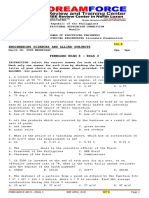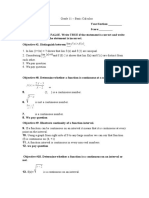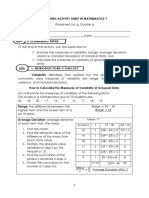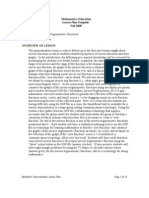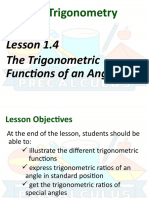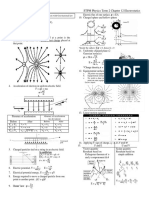Applications of Derivatives
Uploaded by
James Bennedict TioApplications of Derivatives
Uploaded by
James Bennedict TioOVERVIEW
This module aims to prepare students in their Grade 11 Differential Calculus class. It consist of four
(3) essential lessons based on the prerequisite requirements of Mathematics 6. This module allows
them to use self-directed learning and maximize online resources available.
The THINK framework was adopted in the creation of this module – a design that employs a
deductive mode of teaching. Each lesson is consist of six sections with the following components:
Target (Objectives), Hook (Motivation), Ignite (Lesson Proper), Navigate (Formative Assessments)
and Knot (Summative Assessment).
Campus: Ilocos Region
Grade Level: 11
Subject/Topic: Mathematics 5 – Applications of Derivative
Target Number of Sessions: 3
Rates of Change
Rectilinear Motion
Related Rates
Resources or Materials Needed: Copy of this module, internet connection, laptop or cellphone
PHILIPPINE SCIENCE HIGH SCHOOL ILOCOS REGION CAMPUS
Mathematics 5: SY 2019-2020 Page 1 of 16
Lesson
APPLICATIONS OF DERIVATIVE
TARGET
At the end of this lesson, you are expected to:
Solve real-world problems applying derivatives (e.g., rectilinear motion, rates of change, related rates,
and optimization)
IGNITE
RATES OF CHANGE
HOOK
Rates of change occur in many applications. A microbiologist might be interested in the rate at which
the number of bacteria in a culture changes with time. An engineer might be interested in the rate at
which the length of a metal rod changes with temperature. An economist might be interested in the
rate at which production cost changes with the quantity of a product that is manufactured. A medical
researcher might be interested in the rate at which the radius of an artery changes with the
concentration of alcohol in the bloodstream.
Take for example, a hot air balloon started rising vertically from the ground and after 10 seconds, it
was observed to be at an altitude of 40 feet from the ground. Thirty (30) seconds after it left the
ground, it was found to be 100 feet from the ground. On average, what was its speed between the
10th and the 30th second? The average speed can be computed by dividing the change in height by
the change in time. That is,
100 − 40 60 𝑓𝑡
𝑠̅ = = =3
30 − 10 20 s
𝑓𝑡
What does this mean? Is the velocity at each moment equal to 3 s ? Not necessarily. In general, given
𝑦 = 𝑓(𝑥), we can measure how fast 𝑦 changes with respect to changes in 𝑥. This gives us a new
interpretation for the derivative. Aside from giving the slope of a tangent line, it gives an instantaneous
rate of change.
PHILIPPINE SCIENCE HIGH SCHOOL ILOCOS REGION CAMPUS
Mathematics 5: SY 2019-2020 Page 2 of 16
Definitions
1. Suppose 𝑓 is a function and 𝑦 = 𝑓(𝑥). The average rate of change of 𝑦 with respect to 𝑥 on
[𝑥0 , 𝑥] is
𝑓(𝑥 ) − 𝑓(𝑥0 ) ∆𝑓
=
𝑥 − 𝑥0 ∆𝑥
2. Suppose 𝑓 is a function and 𝑦 = 𝑓(𝑥). The instantaneous rate of change of 𝑦 with respect to 𝑥
at 𝑥 = 𝑥0 is
𝑓 (𝑥 ) − 𝑓 (𝑥 0 ) ∆𝑓
lim = lim = 𝑓′(𝑥0 )
𝑥→𝑥0 𝑥 − 𝑥0 ∆𝑥 ∆𝑥
3. Graphically, the average rate of change of 𝑦 with respect to 𝑥 on [𝑥0 , 𝑥] is the slope of the
secant line passing through 𝑃(𝑥0 , 𝑓(𝑥0 )) and 𝑄(𝑥, 𝑓(𝑥)).
4. The derivative of 𝑓 at 𝑥 = 𝑥0 , 𝑓′(𝑥0 ) can be interpreted as the instantaneous rate of change of
𝑦 with respect at 𝑥 at 𝑥 = 𝑥0 . That is, 𝑓′(𝑥0 ) is the rate of change of 𝑦 per unit change in 𝑥 at
the instant when 𝑥 = 𝑥0 .
5. Let 𝑦 be a function of 𝑥.
𝑑𝑦
(i) If > 0 on an interval 𝐼 , then 𝑦 increases as 𝑥 increases, and 𝑦 decreases as 𝑥
𝑑𝑥
decreases.
𝑑𝑦
(ii) If 𝑑𝑥
< 0 on an interval 𝐼 , then 𝑦 decreases as 𝑥 increases, and 𝑦 increases as 𝑥
decreases.
𝑑𝑦
(iii) If 𝑑𝑥 = 0 on an interval 𝐼, then 𝑦 does not change with respect to 𝑥.
Example
A right circular cylinder has a fixed height of 𝟔 units. Find the rate of change of its volume with respect
to the radius of its base.
Solution:
𝑑𝑉
Find .
𝑑𝑟
𝑉 = 𝜋𝑟 2 ℎ = 6𝜋𝑟 2
𝒅𝑽
∴ = 12𝜋𝑟
𝒅𝒓
Example
A bactericide was introduced to a nutrient broth in which bacteria were growing. The bacterium
population continued to grow for some time but then stopped growing and began to decline.
The size of the population at time 𝑡 (hours) was
𝑃 = 106 + 104 𝑡 − 103 𝑡 2 .
Determine the growth rates at 𝑡 = 0, 𝑡 = 5 and 𝑡 = 10 hours.
Solution:
The growth rate or the rate of change of the bacterium population 𝑃 with respect to time 𝑡 is given by
𝑃′(𝑡).
This implies that
𝑃′ (𝑡) = 104 − 2(103 )𝑡 = 2(103 )(5 − 𝑡)
∴ 𝑃 (0) = 10 , 𝑃 (5) = 0, and 𝑃 (10) = −104
′ 4 ′ ′
PHILIPPINE SCIENCE HIGH SCHOOL ILOCOS REGION CAMPUS
Mathematics 5: SY 2019-2020 Page 3 of 16
Notice that given 𝑃′ (𝑡) = 104 − 2(103 )𝑡 = 2(103 )(5 − 𝑡), 𝑃′ (𝑡) > 0 when 𝑡 ∈ [0,5) and 𝑃′ (𝑡) <
0 when 𝑡 ∈ (5, +∞) Thus, the bacterium population was increasing until 𝑡 = 5 hours, then it stopped
growing and began to decline.
NAVIGATE
Now, it’s time for you to apply what you have learned.
Exercise 1
A ladder 24 feet long rests against a vertical wall. (See Figure 1). Let 𝜃 be the angle between the top
of the ladder and the wall and let 𝑥 be the distance from the bottom of the ladder to the wall. If the
bottom of the ladder slides away from the wall, how fast does 𝑥 change with respect to 𝜃 when 𝜃 =
𝜋
? (Solution on the last page.)
3
[Illustration of the problem]. (n.d.). https://sites.google.com/site/updmathsite/
Figure 1
IGNITE
RECTILINEAR MOTION
HOOK
Suppose a particle is moving along a straight line, which we shall refer to as the 𝑠-axis. Suppose the
position of the particle at time 𝑡 is given by the function 𝑠(𝑡), called the position function of the particle.
The average velocity of the particle on [𝑡0 , 𝑡] is
𝑠(𝑡) − 𝑠(𝑡0 ) ∆𝑠
𝑣𝑎𝑣𝑒𝑟𝑎𝑔𝑒 = =
𝑡 − 𝑡0 ∆𝑡
PHILIPPINE SCIENCE HIGH SCHOOL ILOCOS REGION CAMPUS
Mathematics 5: SY 2019-2020 Page 4 of 16
Definition
Let 𝒔(𝒕) be the position function of a particle moving along s-axis.
(i) The instantaneous velocity of the particle at time 𝑡 is
∆𝑠 𝑑𝑠
𝑣(𝑡) = lim = = 𝑓′(𝑡)
∆𝑡→0 ∆𝑡 𝑑𝑡
(ii) The instantaneous speed of the particle at time 𝑡 is |𝑣(𝑡)|.
(iii) The instantaneous acceleration of the particle at time 𝑡 is
∆𝑣 𝑑𝑣
𝑎(𝑡) = lim = = 𝑣 ′ (𝑡 )
∆𝑡→0 ∆𝑡 𝑑𝑡
or,
𝑑2𝑠
𝑎(𝑡) = 2 = 𝑓′′(𝑡)
𝑑𝑡
Remarks
Let 𝑠(𝑡) be the position function of a particle moving along the 𝑠-axis. The signs of 𝑣(𝑡) and 𝑎(𝑡) give
us information about the motion of the particle
1. If 𝑣(𝑡) > 0, then the particle is moving in the positive direction of 𝑠 (usually to the right or
upward) at time 𝑡.
2. If 𝑣(𝑡) < 0, then the particle is moving in the negative direction of 𝑠 (usually to the left or
downward) at time 𝑡.
3. If 𝑣(𝑡) = 0, either the particle is not moving or is changing direction at time 𝑡.
4. If 𝑎(𝑡) > 0, then the velocity of the particle is increasing at time 𝑡. In addition,
(a) if 𝑣(𝑡) > 0 then the speed of the particle is increasing at time 𝑡 (speeding up).
(b) if 𝑣(𝑡) < 0 then the speed of the particle is decreasing at time 𝑡 (slowing down).
5. If 𝑎(𝑡) < 0, then the velocity of the particle is decreasing at time 𝑡. In addition,
(a) if 𝑣(𝑡) > 0 then the speed of the particle is decreasing at time 𝑡.
(b) if 𝑣(𝑡) < 0 then the speed of the particle is increasing at time 𝑡.
6. If 𝑎(𝑡) = 0, then the velocity of the particle is constant. (This does not mean that the particle is
NOT moving!)
That is, the particle is speeding up when 𝑣(𝑡) and 𝑎(𝑡) have the same sign, and slowing down when
𝑣(𝑡) and 𝑎(𝑡) are opposite in sign.
Example
A particle moves along a horizontal coordinate line in such a way that its position at time 𝑡 is specified
by 𝑠(𝑡) = 𝑡 3 − 12𝑡 2 + 36𝑡 − 30 where 𝑠 is measured in feet and 𝑡 in seconds.
(a) Find the instantaneous velocity and the instantaneous acceleration in terms of 𝑡.
(b) Describe the position and motion of the particle in a table that includes the intervals of time
when the particle is moving to the left or to the right, when the velocity is increasing or
decreasing, when the speed is increasing or decreasing, and the particle’s position with
respect to the origin during these intervals of time.
(c) Show the motion of the particle schematically.
(d) Determine the total distance traveled by the particle during the first 7 seconds.
PHILIPPINE SCIENCE HIGH SCHOOL ILOCOS REGION CAMPUS
Mathematics 5: SY 2019-2020 Page 5 of 16
Solution (a):
Using the definition,
𝑑𝑠
𝑣 (𝑡 ) = = 3𝑡 2 − 24𝑡 + 36
𝑑𝑡
and
𝑑𝑣
𝑎 (𝑡 ) = = 6𝑡 − 24
𝑑𝑡
Solution (b):
First, find 𝑡 ≥ 0 such that 𝑣 (𝑡) = 0 and 𝑎(𝑡) = 0.
𝑣 (𝑡 ) =0 𝑎(𝑡) =0
2
3𝑡 − 24𝑡 + 36 =0 6𝑡 − 24 =0
3(𝑡 − 6)(𝑡 − 2) =0 6(𝑡 − 4) =0
𝑡1 =6 𝑡3 =4
=2 𝑡2
3 2
Note that 𝑠 𝑡 = 𝑡 − 12𝑡 + 36𝑡 − 30, 𝑣(𝑡) = 3(𝑡 − 6)(𝑡 − 2), and 𝑎(𝑡) = 6(𝑡 − 4).
( )
𝒔(𝒕) 𝒗(𝒕) 𝒂( 𝒕 ) CONCLUSIONS
𝑡=0 −30 + − left of origin, towards right, decreasing velocity, slowing down
0<𝑡<2 + − towards right, decreasing velocity, slowing down
𝑡=2 2 0 − right of origin, changing direction, decreasing velocity
2<𝑡<4 − − towards left, decreasing velocity, speeding up
𝑡=4 −14 − 0 left of origin, towards left, constant velocity
4<𝑡<6 − + towards left, increasing velocity, slowing down
𝑡=6 −30 0 + left of origin, changing direction, increasing velocity
𝑡>6 + + towards right, increasing velocity, speeding up
Solution (c):
Schematically, the particle moved in the following way:
[Schematic motion of the particle]. (n.d.). https://sites.google.com/site/updmathsite/
Figure 2
Solution (d):
Note that the particle changed directions at 𝑡 = 2 and 𝑡 = 6. (See Figure 2).
The total distance traveled
= |𝑠(2) − 𝑠(0)| + |𝑠(6) − 𝑠(2)| + |𝑠(7) − 𝑠(6)|
= 32 + 32 + 7 = 71 feet
PHILIPPINE SCIENCE HIGH SCHOOL ILOCOS REGION CAMPUS
Mathematics 5: SY 2019-2020 Page 6 of 16
Example
A ball was thrown from the edge of a cliff such that its directed distance from the ground after 𝑡
seconds is given by 𝑠(𝑡) = −16𝑡 2 + 32𝑡 + 128 feet. Determine:
(a) the acceleration of the ball at 𝑡 = 3.
(b) the maximum height the ball will attain.
(c) the velocity at which the ball was thrown.
(d) how long it would take the ball to hit the ground.
(e) the speed at which the ball would hit the ground.
Solution (a):
𝑑𝑠
Using the definition, 𝑣 (𝑡) = 𝑑𝑡 = −32𝑡 + 32
Then,
𝑑𝑣 𝑓𝑡
𝑎 (𝑡 ) = = −32 2
𝑑𝑡 𝑠
Solution (b):
Since the graph of 𝑠 is a parabola opening downward, the maximum value is attained at the vertex.
The 𝑡−coordinate is
−32 32
= =1
2(−16) 32
The 𝑠−coordinate is
𝑠(1) = −16(1) + 32(1) + 128 = 144 𝑓𝑒𝑒𝑡
Solution (c):
The velocity at which the ball was thrown was 𝑣(0).
Since 𝑣 (𝑡) == 32𝑡 + 32, then
𝑓𝑡
𝑣(0) = −32(0) + 32 = 32
𝑠
Solution (d) and (e):
First, find 𝑡 ≥ 0 such that 𝑠(𝑡) = 0.
𝑠 (𝑡 ) =0
−16(𝑡 2 − 2𝑡 − 8) =0
−16(𝑡 − 4)(𝑡 + 2) =0
𝑡1 =4
𝑡2 = −2
Since 𝑡 ≥ 0, the ball would hit the ground after 4 seconds. It would hit the ground at a speed of
𝑓𝑡
|𝑣 (4)| = |−32(4) + 32| = 96
𝑠
PHILIPPINE SCIENCE HIGH SCHOOL ILOCOS REGION CAMPUS
Mathematics 5: SY 2019-2020 Page 7 of 16
KNOT
SUMMATIVE TEST 1
INSTRUCTION: Answer the following. Show your complete and neat solution.
The position function of a particle moving along a coordinate line is 𝑠(𝑡) = 6𝑡 2 − 𝑡 3 , where 𝑠 is in feet
and 𝑡 is in seconds.
1. Determine the velocity and acceleration functions.
2. When is the particle speeding up?
IGNITE
RELATED RATES
HOOK
[Image of a water ripple]. (n.d.). https://kfblaw.com/news/giving/
Figure 3
Take a look at Figure 3. As the radius increases, the area of the ripple increases. It shows that, how
fast the area changes depends on how fast radius changes. Problem on related rates are problems
involving rates of change of several variables where one variable is dependent on one or more other
variables.
𝑑𝑥
Let 𝑥 be a quantity that is a function of time 𝑡. This implies that is the rate of change of 𝑥 with
𝑑𝑡
𝑑𝑦 𝑑𝑥
respect to 𝑡. Suppose 𝑦 is dependent on 𝑥. Then, is dependent on .
𝑑𝑡 𝑑𝑡
PHILIPPINE SCIENCE HIGH SCHOOL ILOCOS REGION CAMPUS
Mathematics 5: SY 2019-2020 Page 8 of 16
Notes
𝒅𝒙
• > 0 ∀ 𝑡 > 0 ⟹ 𝑥 increases through time
𝒅𝒕
𝑑𝑥
• < 0 ∀ 𝑡 > 0 ⟹ 𝑥 decreases through time
𝑑𝑡
𝑑𝑥
• = 0 ∀ 𝑡 > 0 ⟹ 𝑥 remains constant through time
𝑑𝑡
SOLVING PROBLEMS INVOLVING RELATED RATES
(1) Let 𝑡 denote the elapsed time. If possible, draw a diagram of the problem that is valid for any
time 𝑡 > 0.
(2) Select variables to represent the quantities that change with respect to time. Label those
quantities whose values do not depend on 𝑡 with their given constant values.
(3) Write down any numerical facts known about the variables. Interpret each rate of change as
the derivative of a variable with respect to time.
(4) Identify what is being asked.
(5) Write an equation relating the variables that is valid at all time 𝑡 > 0.
(6) Differentiate the equation in step 5 implicitly with respect to 𝑡.
(7) Substitute in the equation obtained in step 6 all values that are valid at the particular time of
interest. Solve for what is being asked.
(8) Write a conclusion that answers the question of the problem. Do not forget to include the
correct units of measurement.
Example
A ladder 10 meters long is leaning against a wall. If the bottom of the ladder is being pulled horizontally
towards the wall at 2 m/s, how fast is the top of the ladder moving when the bottom is 6 meters from the
wall?
Solution:
(1) Let 𝑡 denote the elapsed time. If possible, draw a diagram of the problem that is valid for any
time 𝑡 > 0. (See Figure 4)
[Illustration of the problem]. (n.d.). https://sites.google.com/site/updmathsite/
Figure 4
PHILIPPINE SCIENCE HIGH SCHOOL ILOCOS REGION CAMPUS
Mathematics 5: SY 2019-2020 Page 9 of 16
(2) Select variables to represent the quantities that change with respect to time. Label those
quantities whose values do not depend on 𝑡 with their given constant values.
[Illustration of the problem with values]. (n.d.). https://sites.google.com/site/updmathsite/
Figure 5
(3) Write down any numerical facts known about the variables. Interpret each rate of change as
the derivative of a variable with respect to time.
𝑑𝑥 𝑚
= −2
𝑑𝑡 𝑠
[Illustration of the problem with numerical facts]. (n.d.). https://sites.google.com/site/updmathsite/
Figure 6
(4) Identify what is being asked.
𝑑𝑦
| =?
𝑑𝑡 𝑥=6
(5) Write an equation relating the variables that is valid at all time 𝑡 > 0.
𝑥 2 + 𝑦 2 = 100
(6) Differentiate the equation in step 5 implicitly with respect to 𝑡.
𝐷𝑡 [𝑥 2 + 𝑦 2 ] = 𝐷𝑡 [100]
𝑑𝑥 𝑑𝑦
2𝑥 𝑑𝑡 + 2𝑦 𝑑𝑡 = 0
𝑑𝑦 𝑥 𝑑𝑥
= − 𝑦 𝑑𝑡
𝑑𝑡
(7) Substitute in the equation obtained in step 6 all values that are valid at the particular time of
interest. Solve for what is being asked.
𝑑𝑦 𝑥 𝑑𝑥 𝑑𝑥
Note that 𝑥 2 + 𝑦 2 = 100, =− , and = −2.
𝑑𝑡 𝑦 𝑑𝑡 𝑑𝑡
When 𝑥 = 6,
36 + 𝑦 2 = 100 ⇒ 𝑦 2 = 64 ⇒ 𝑦 = 8 (since 𝑦 > 0)
PHILIPPINE SCIENCE HIGH SCHOOL ILOCOS REGION CAMPUS
Mathematics 5: SY 2019-2020 Page 10 of 16
then,
𝑑𝑦 6 3
| = (− ) (−2) =
𝑑𝑡 𝑥=6 8 2
(8) Write a conclusion that answers the question of the problem. Do not forget to include the
correct units of measurement.
𝟑𝒎
∴ The top of the ladder is sliding up the wall at a rate of 𝟐 when the bottom of the ladder is 𝟔
𝒔
meters from the wall.
Example
𝑓𝑡
An automobile traveling at a rate of 20 is approaching an intersection. When the automobile is 100
𝑠
𝑓𝑡
feet from the intersection, a truck traveling at the rate of 40 crosses the intersection. The
𝑠
automobile and the truck are on roads that are at right angles to each other. How fast are the truck
and the automobile separating 2 seconds after the truck leaves the intersection?
Solution:
When 𝑡 > 0,
𝑑𝑥 = 𝑓𝑡
𝑑𝑡
−20 𝑠
𝑑𝑦 = 𝑓𝑡
𝑑𝑡
40 𝑠
𝑑𝑧 = ?
| 𝑡=2
𝑑𝑡
[Illustration of the problem]. (n.d.). https://sites.google.com/site/updmathsite/
Figure 7
Since 𝑥 2 + 𝑦 2 = 𝑧 2 , then
𝐷𝑡 [𝑥 2 + 𝑦 2 ] = 𝐷𝑡 [𝑧 2 ]
𝑑𝑥 𝑑𝑦 𝑑𝑧
2𝑥 𝑑𝑡 + 2𝑦 𝑑𝑡 = 2𝑧 𝑑𝑡
𝑑𝑧 1 𝑑𝑥 𝑑𝑦
= (𝑥 𝑑𝑡 + 𝑦 𝑑𝑡 )
𝑑𝑡 𝑧
At 𝑡 = 2,
𝑥 = 100 − 40 = 60
𝑦 = 80
𝑧 = √602 + 802 = 100
PHILIPPINE SCIENCE HIGH SCHOOL ILOCOS REGION CAMPUS
Mathematics 5: SY 2019-2020 Page 11 of 16
Then,
𝑑𝑧 1 2000
| 𝑡=2 = [60(−20) + 80(40)] =
= 20
𝑑𝑡
100 100
𝒇𝒕
∴ The distance between them is increasing at a rate of 𝟐𝟎 𝒔 after 𝟐 seconds.
Example
A particle is moving along the curve 𝒚 = √𝒙. As the particle passes through the point (𝟒, 𝟐), its
𝒄𝒎
𝒙-coordinate increases at the rate of 𝟑 𝒔 . How fast is the distance from the particle to the origin
changing at this instant?
Solution:
Let 𝑉 be the volume of water in the cone.
𝑑𝑥 𝑐𝑚
| (4,2) = 3 𝑠
𝑑𝑡
𝑑𝑧
| (4,2) = ?
𝑑𝑡
𝑧 = √(𝑥 − 0)2 + (𝑦 − 0)2
𝑧 = √𝑥 2 + 𝑦 2
Figure 8
𝑑𝑦
There’s no value for but 𝑦 = √𝑥. By substitution, 𝑧 = √𝑥 2 + 𝑥.
𝑑𝑡
By differentiating 𝑧 with respect to 𝑡,
𝑑𝑧 1 𝑑𝑥 𝑑𝑥
= (2𝑥 + )
𝑑𝑡 2√𝑥 2 + 𝑥 𝑑𝑡 𝑑𝑡
Then,
𝑑𝑧 1 27 27√5
| (4,2) = [2(4)(3) + (3)] = =
𝑑𝑡 2√42 +4 2√20 20
𝟐𝟕√𝟓 𝒄𝒎
∴ The distance is increasing at a rate of when the particle is at 𝑷(𝟒, 𝟐).
𝟐𝟎 𝒔
PHILIPPINE SCIENCE HIGH SCHOOL ILOCOS REGION CAMPUS
Mathematics 5: SY 2019-2020 Page 12 of 16
NAVIGATE
Now, it’s time for you to apply what you have learned.
Exercise 2
Water is pouring into an inverted cone at the rate of 8 cubic feet per minute. If the height of the cone is
12 feet and the radius of its base is 6 feet, how fast is the water level rising when the water is 4 feet
deep? (Solution on the last page.)
KNOT
SUMMATIVE TEST 2
INSTRUCTION: Answer the following. Show your complete and neat solution.
1. A woman standing on a cliff is watching a motor boat as the boat approaches the shoreline
directly below her. If the woman’s eyes are 250 feet above the water level and if the boat is
approaching at 30 feet per second, how fast is the angle of depression of the boat from the
woman’s eyes changing when the boat is 250 feet from the shore?
2. Gravel is being dumped from a conveyor belt at a rate of 30 cubic feet per minute so that it
forms a pile in the shape of a cone whose height and base diameter are always equal. How
fast is the height of the pile increasing when the pile is 10 feet high?
3. A sponge is in the shape of right circular cone. As it soaks up water it grows in size. At
𝑖𝑛
certain moment, the height is 6 inches and increasing at 0.3 , while radius is 4 inches and
𝑠
𝑖𝑛
increasing at 0.2 . How is the volume changing at that time?
𝑠
4. A balloon that is in the shape of sphere is being inflated at the rate of 20 cubic inches per
minute. At the moment that the sphere has volume of 64 cubic inches, what is the rate the
rate of change of the radius?
5. A 13-foot ladder leans against the wall. The foot of the ladder begins to slide away from the
wall at the rate of 1 foot per minute. When the foot is 5 feet from the wall, at what rate is the
top of the ladder falling?
PHILIPPINE SCIENCE HIGH SCHOOL ILOCOS REGION CAMPUS
Mathematics 5: SY 2019-2020 Page 13 of 16
REFERENCES
J. Albarico (PSHS-CBZRC), THINK Framework. Based on Science Links by E.G. Ramos and N.
Apolinario, Quezon City: Rex Bookstore. (undated)
Liethold L. (2002). The Calculus 7. Addison Wesley Publishing Company Inc.
Stewart J. (2015). Calculus Early Transcendentals. Printed in the United States of America
UP Institute of Mathematics Material for Math 53
Prepared by:
JAS VICTOR I. BUSCAS
Special Science Teacher IV
PHILIPPINE SCIENCE HIGH SCHOOL ILOCOS REGION CAMPUS
Mathematics 5: SY 2019-2020 Page 14 of 16
SOLUTIONS TO EXERCISES
EXERCISE 1
Solution:
From the figure, the equation that relates 𝑥 and 𝜃 is
𝑥
sin 𝜃 =
24
𝑑𝑥 𝜋
We want to find 𝑑𝜃 at 𝜃 = 3 .
𝑥 = 24 sin 𝜃
𝑑𝑥
= 24 cos 𝜃
𝑑𝜃
𝜋
At 𝜃 = 3 ,
𝑑𝑥 𝜋 𝑓𝑡
| 𝜋 = 24 cos = 12
𝑑𝜃 𝜃= 3 3 𝑟𝑎𝑑
𝜋 𝑓𝑡
∴ When 𝜃 = , the distance from the bottom of the ladder to the wall changes at 12 .
3 𝑟𝑎𝑑
EXERCISE 2
Solution:
Let 𝑉 be the volume of water in the cone.
𝑉 = 1
𝜋𝑟 2 ℎ
3
𝑑𝑉 = 𝑓𝑡 3
𝑑𝑡 8 𝑚𝑖𝑛
𝑑ℎ = ?
| ℎ=4
𝑑𝑡
[Illustration of the problem]. (n.d.). https://sites.google.com/site/updmathsite/
Figure 25
𝑑𝑟
However, there’s no value for 𝑑𝑡 . To get this, express 𝑟 in terms of ℎ. By similar triangles,
𝑟 6 ℎ
= ⇒𝑟=
ℎ 12 2
Substituting the value of 𝑟 to 𝑉,
1 ℎ 2 1 ℎ2 𝜋ℎ3
𝑉 = 𝜋( ) ℎ = 𝜋( )ℎ =
3 2 3 4 12
By differentiating 𝑉 with respect to 𝑡,
PHILIPPINE SCIENCE HIGH SCHOOL ILOCOS REGION CAMPUS
Mathematics 5: SY 2019-2020 Page 15 of 16
𝑑𝑉 𝜋 2 𝑑ℎ
= ℎ
𝑑𝑡 4 𝑑𝑡
which implies that,
𝑑ℎ 4 𝑑𝑉
= 2
𝑑𝑡 𝜋ℎ 𝑑𝑡
Then,
𝑑ℎ 4 4 2
| ℎ=4 = (8) = (8) =
𝑑𝑡 𝜋 (4 2 ) 𝜋(16) 𝜋
2 𝑓𝑡
∴ The water level is rising at 𝜋 when the water is 4 feet deep.
𝑚𝑖𝑛
PHILIPPINE SCIENCE HIGH SCHOOL ILOCOS REGION CAMPUS
Mathematics 5: SY 2019-2020 Page 16 of 16
You might also like
- Semi-Detailed Lesson Plan in Mathematics 10No ratings yetSemi-Detailed Lesson Plan in Mathematics 104 pages
- Learning Activity Sheet in Mathematics 7No ratings yetLearning Activity Sheet in Mathematics 76 pages
- Calculus Reviewer For Licensure Examinations FINALNo ratings yetCalculus Reviewer For Licensure Examinations FINAL10 pages
- Modern Geometry: Power Point PresentationNo ratings yetModern Geometry: Power Point Presentation20 pages
- Lesson: Identifying The Regions of Areas Under The Normal CurveNo ratings yetLesson: Identifying The Regions of Areas Under The Normal Curve10 pages
- Limits of Exponential and Logarithmic Functions0% (1)Limits of Exponential and Logarithmic Functions15 pages
- Measures of Variability For Ungrouped Data100% (1)Measures of Variability For Ungrouped Data16 pages
- Solving Logarithmic Inequalities: General MathematicsNo ratings yetSolving Logarithmic Inequalities: General Mathematics61 pages
- Week2 L4 5 Limits of Transcendental FunctionsNo ratings yetWeek2 L4 5 Limits of Transcendental Functions30 pages
- Parabolas: Mhel Brian G. Dayon (Em Bi) 0998-1591-389100% (1)Parabolas: Mhel Brian G. Dayon (Em Bi) 0998-1591-38911 pages
- Lesson 9 Integration of Hyperbolic FunctionsNo ratings yetLesson 9 Integration of Hyperbolic Functions12 pages
- Study Guide 1.6 - Systems of Non-Linear EquationNo ratings yetStudy Guide 1.6 - Systems of Non-Linear Equation8 pages
- Solving Logarithmic Equations and Inequalities Part 1100% (1)Solving Logarithmic Equations and Inequalities Part 19 pages
- Daily Lesson Log of Stem - Bc11Lc-Iiib-2: 1. Explain How The Answer Was Arrived at 2. 3. 4No ratings yetDaily Lesson Log of Stem - Bc11Lc-Iiib-2: 1. Explain How The Answer Was Arrived at 2. 3. 42 pages
- Measures of Central Tendency and VariabilityNo ratings yetMeasures of Central Tendency and Variability24 pages
- DAILY LESSON LOG OF STEM - PC11AG-Ia-2,3,4 (Week One-Day Three)No ratings yetDAILY LESSON LOG OF STEM - PC11AG-Ia-2,3,4 (Week One-Day Three)3 pages
- Lesson Plan: Proof by Mathematical InductionNo ratings yetLesson Plan: Proof by Mathematical Induction5 pages
- 4Q Lesson 1 Measures of Position For Ungrouped Data100% (1)4Q Lesson 1 Measures of Position For Ungrouped Data22 pages
- Q4 Determine Quartiles of Ungrouped Data Using Mendelhall Sincich Method and Linear InterpolationNo ratings yetQ4 Determine Quartiles of Ungrouped Data Using Mendelhall Sincich Method and Linear Interpolation25 pages
- Basic Calculus q3 w6 Lesson 61 Determine The Relationship Between Diffentiability and Continuity of A FunctionNo ratings yetBasic Calculus q3 w6 Lesson 61 Determine The Relationship Between Diffentiability and Continuity of A Function5 pages
- Mathematics in The Modern World Midterm ExaminationNo ratings yetMathematics in The Modern World Midterm Examination2 pages
- Synthetic Division: Learning Activity SheetNo ratings yetSynthetic Division: Learning Activity Sheet10 pages
- M53 Lec2.4 Rates of Change and Rectilinear MotionNo ratings yetM53 Lec2.4 Rates of Change and Rectilinear Motion30 pages
- The Warping Torsion Bar Model of The Differential Quadrature MethodNo ratings yetThe Warping Torsion Bar Model of The Differential Quadrature Method9 pages
- Full download The Lattice Boltzmann Method: Principles and Practice 1st Edition Timm Krüger pdf docx100% (3)Full download The Lattice Boltzmann Method: Principles and Practice 1st Edition Timm Krüger pdf docx55 pages
- Theoretical Basics of Experimental Phenomena100% (1)Theoretical Basics of Experimental Phenomena23 pages
- Exo Endothermic BA and Its Foaming BehaviourNo ratings yetExo Endothermic BA and Its Foaming Behaviour11 pages
- Interactions Unit 3 Chapter 1 Sample Quiz Key: Use Your Scientists' Consensus Ideas Sheets For AssistanceNo ratings yetInteractions Unit 3 Chapter 1 Sample Quiz Key: Use Your Scientists' Consensus Ideas Sheets For Assistance7 pages
- D16.7 Relative Motion Analysis - AccelerationNo ratings yetD16.7 Relative Motion Analysis - Acceleration5 pages
- Calculus Reviewer For Licensure Examinations FINALCalculus Reviewer For Licensure Examinations FINAL
- Lesson: Identifying The Regions of Areas Under The Normal CurveLesson: Identifying The Regions of Areas Under The Normal Curve
- Solving Logarithmic Inequalities: General MathematicsSolving Logarithmic Inequalities: General Mathematics
- Parabolas: Mhel Brian G. Dayon (Em Bi) 0998-1591-389Parabolas: Mhel Brian G. Dayon (Em Bi) 0998-1591-389
- Solving Logarithmic Equations and Inequalities Part 1Solving Logarithmic Equations and Inequalities Part 1
- Daily Lesson Log of Stem - Bc11Lc-Iiib-2: 1. Explain How The Answer Was Arrived at 2. 3. 4Daily Lesson Log of Stem - Bc11Lc-Iiib-2: 1. Explain How The Answer Was Arrived at 2. 3. 4
- DAILY LESSON LOG OF STEM - PC11AG-Ia-2,3,4 (Week One-Day Three)DAILY LESSON LOG OF STEM - PC11AG-Ia-2,3,4 (Week One-Day Three)
- 4Q Lesson 1 Measures of Position For Ungrouped Data4Q Lesson 1 Measures of Position For Ungrouped Data
- Q4 Determine Quartiles of Ungrouped Data Using Mendelhall Sincich Method and Linear InterpolationQ4 Determine Quartiles of Ungrouped Data Using Mendelhall Sincich Method and Linear Interpolation
- Basic Calculus q3 w6 Lesson 61 Determine The Relationship Between Diffentiability and Continuity of A FunctionBasic Calculus q3 w6 Lesson 61 Determine The Relationship Between Diffentiability and Continuity of A Function
- Mathematics in The Modern World Midterm ExaminationMathematics in The Modern World Midterm Examination
- The Warping Torsion Bar Model of The Differential Quadrature MethodThe Warping Torsion Bar Model of The Differential Quadrature Method
- Full download The Lattice Boltzmann Method: Principles and Practice 1st Edition Timm Krüger pdf docxFull download The Lattice Boltzmann Method: Principles and Practice 1st Edition Timm Krüger pdf docx
- Interactions Unit 3 Chapter 1 Sample Quiz Key: Use Your Scientists' Consensus Ideas Sheets For AssistanceInteractions Unit 3 Chapter 1 Sample Quiz Key: Use Your Scientists' Consensus Ideas Sheets For Assistance


